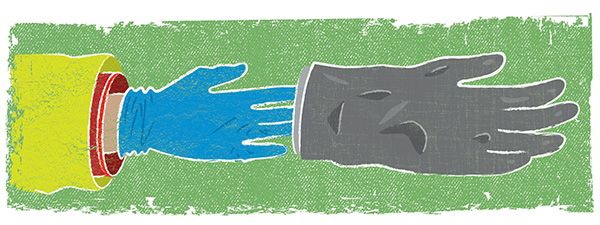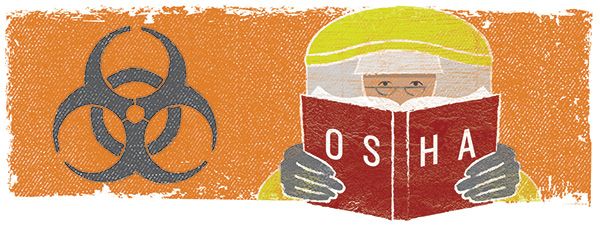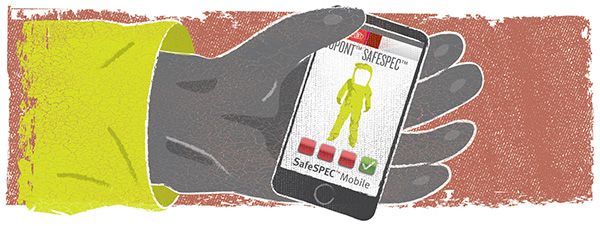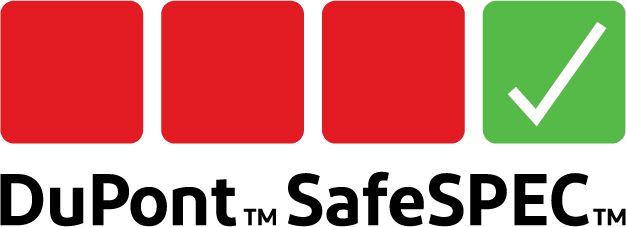Donning and Doffing: “Who’s There?”
By Terry DeGuentz, BS, NRP
Chief of Emergency Services, DuPont

During my initial hazardous materials technician training, my class practiced donning and doffing for several days before we began our field exercises. Like many extended fire service classes, this one involved a rote method of learning to reinforce our actions and build an efficient team. With help from a “suit and boot” partner, we repeatedly donned a Tychem® TK Level A suit only to take it off again and switch positions. As part of the drill, we applied a piece of duct tape to the right and left arms of the suit, marked with the first name of the firefighter wearing the suit.
Comradery among firefighters leads to the occasional practical joke and ribbing, especially after a couple of weeks in each other’s company. Things got interesting when someone would “forget” to change the name on a suit. Needless to say, it’s uncomfortable when you think you’re talking to one of your firefighter buddies only to discover that it’s actually someone else—with rank. Lesson learned: Always know your audience before you start a conversation!
Fogging Face Visor on a Level A Suit
By Dan Bowen
Technical Specialist, DuPont

It’s very common for the visor of a Level A suit to fog on the inside. Although it’s possible for the wearer to remove their hand from the garment’s glove system to clear the visor, there is another solution to this situation. Rather than risk glove inversion, many users will wear an absorbent material on their forehead before donning the garment. When the visor fogs, the wearer can use their gloved hands from outside the suit to push the visor against their forehead and then nod their head to wipe condensation from the inner visor surface. Any soft absorbent material will work. Some popular items are bandanas and sponge strips with an elastic band (readily available from most industrial supply distributors) worn around the head.
Inner Glove Inversion Solutions
By Dan Bowen
Technical Specialist, DuPont

Anyone who has worn a chemical suit with a multi-glove system has probably experienced an inversion of the inner glove. This situation can limit one’s productivity, as it usually takes some time to get the inner glove back into itdigitalData.proper configuration.
Wearing very thin gloves on the hands inside the suit will make it easier to remove a hand from the suit's attached glove system, should it become necessary. Two common glove types are used for this purpose. Some users favor thin nitrile gloves, as they serve both to prevent hand perspiration from getting into the inner suit glove and to provide a degree of protection should the outer gloves become breached during use. Others like to use thin cotton gloves similar to those used by jewelers, often referred to as “examination gloves.” Using either type will make it easier to remove a hand without inverting the inner glove, but care still must be taken when removing the hand, i.e., pulling one finger at a time while holding the glove’s fingertips with the other hand.
The Book of Oz: Hazmat Response Regulation and Standards
By Rick Edinger, EFO
Interim Deputy Chief of Emergency Operations
Chesterfield, VA Fire & EMS

As hazmat responders, we are regulated by specific standards that keep us aligned and protected. Sometimes these standards change or become difficult to understand. This column will provide a “deep dive” into the current standards and provide helpful information about new and changing standards.
Have you ever wondered what guides us to do what we do as hazmat responders? The basis for all hazardous materials response activities in the United States is the Code of Federal Regulations standard 1910.120, Hazardous Waste Operations and Emergency Response, promulgated by the Occupational Safety and Health Administration (OSHA). OSHA 1910.120 applies to any employee who may come into contact with a hazardous material or substance, encompassing both private industry and emergency-response personnel. It dictates how hazardous material/substance response situations should be managed. Like other federal regulations, the requirements carry the weight of federal law.
There are other non-regulatory sources for medical and non-medical incident responses. The primary non-regulatory documents that guide hazardous materials emergency response in the U.S. and Canada are standards published by the National Fire Protection Association (NFPA). Another source is NFPA 472: Standard for Competence of Responders to Hazardous Materials/Weapons of Mass Destruction Incidents, a consensus standard that is ‘cross-walked’ to OSHA 1910.120. It provides more in-depth information and guidance on response to hazardous materials incidents. NFPA 473: Standard for Competence of EMS Responders Responding to Hazardous Materials/Weapons of Mass Destruction Incidents is specific to the medical response to hazmat incidents.
In upcoming articles, we’ll cover more information on these standards and several new hazardous materials response documents that are currently under development by the NFPA.
Rick Edinger, EFO, is the Interim Deputy Chief of Emergency Operations at Chesterfield Fire & EMS (Virginia). He is vice chair of the IAFC Hazardous Materials Committee and a Technical Committee member with NFPA.
DuPont™ SafeSPEC™: Easy-To-Read Product Content and Technical Data at Your Fingertips
By Mark Tartaglia, MSPH, CIH

The DuPont™ SafeSPEC™ online product selector tool is your one-stop hazmat response garment-selection resource. Whether you have a chemical release and need to know which DuPont garment will offer satisfactory permeation resistance, or you’re doing hazmat pre-planning and trying to decide which DuPont garments you need to keep in stock, SafeSPEC™ has answers.
SafeSPEC™ is also available as a mobile app containing the largest database of garment permeation test data, with nearly 2,300 test results available for review. Easy-to-read content, simple navigation and instant access make the tool extremely valuable on the job.
In addition to permeation data, SafeSPEC™ provides physical data for all DuPont garments, including fabric thickness and tear resistance. Need reference information? Need help evaluating the impact of reduced temperature on garment performance? SafeSPEC™ has that information, too.
Stay tuned for future articles about how you can leverage SafeSPEC™ for all your hazmat garment-selection needs.

Resource library
Find technical information, videos, webinars and case studies about DuPont PPE here.


